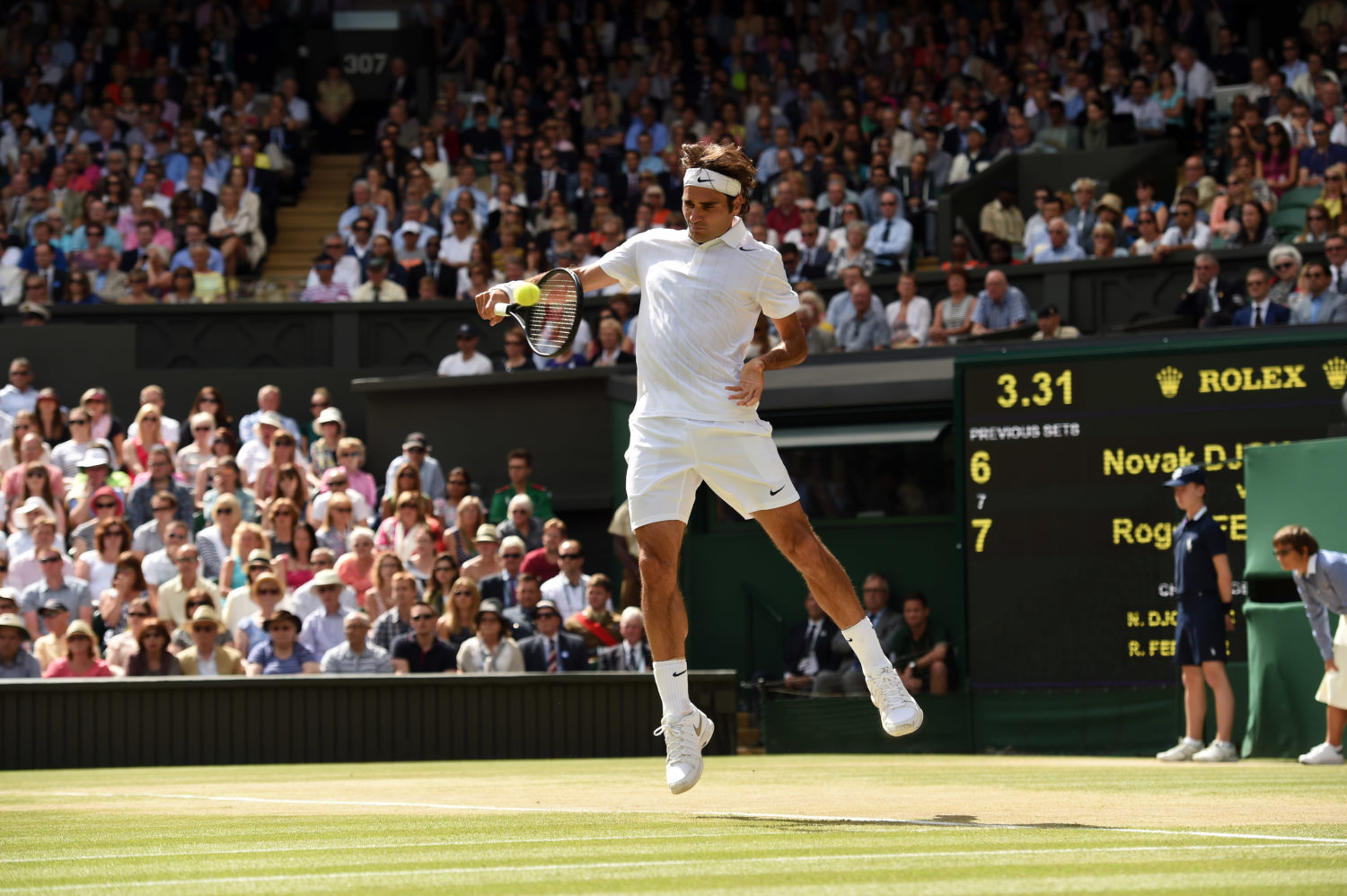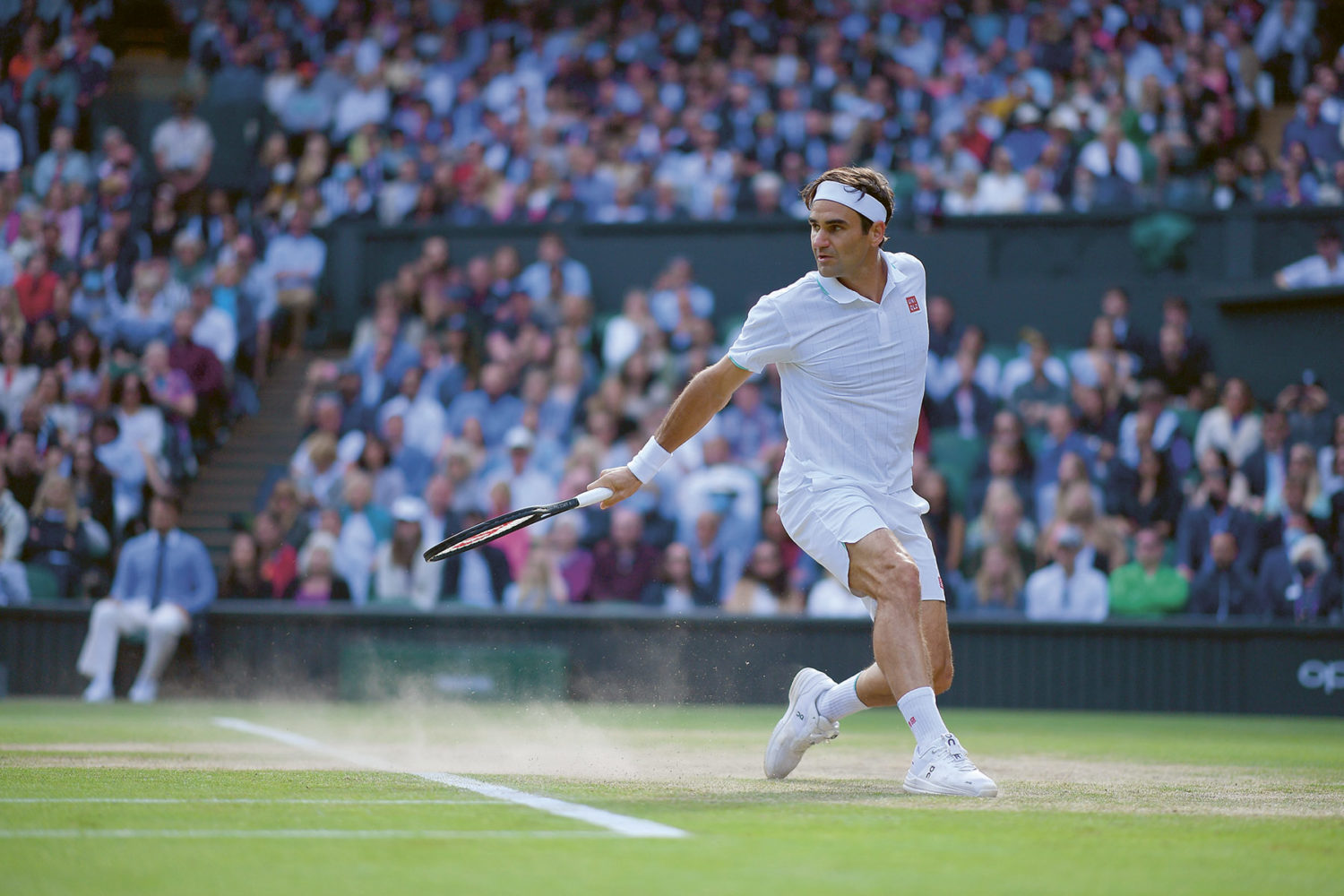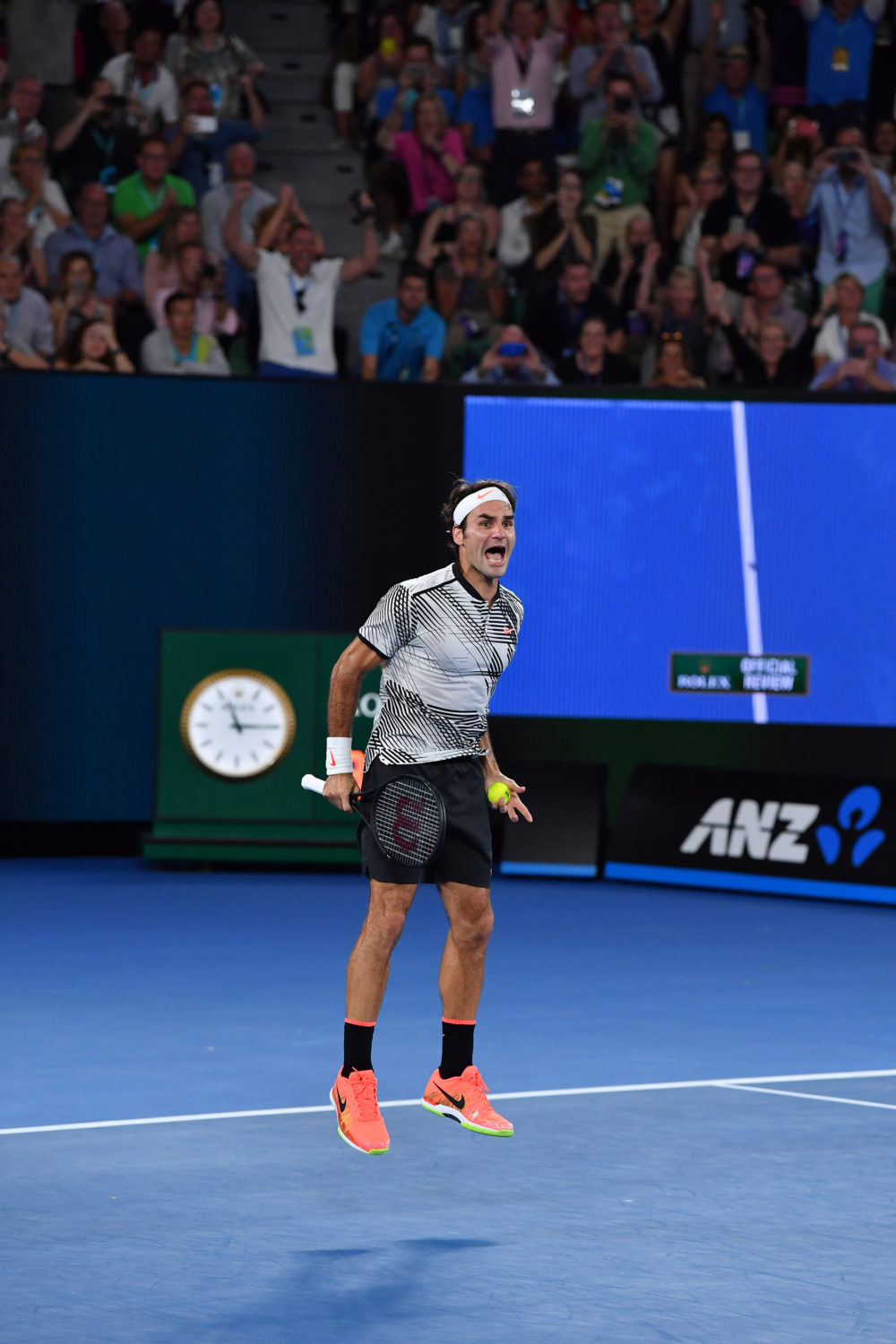Elegant, Competitive, Global
Roger Federer
On His Two Decades on Tour

“I thought to myself, if the greatest player ever, Roger Federer, sat next to me one day on my 30- minute train journey into work, what would we talk about? What do I want to know from him? And in one word it came down to longevity, which was also relevant to the heritage of the Wilson brand. I wanted to know how this guy with four kids who’s a couple of years away from being forty is still able to compete at the very highest level in professional tennis.”
That was the challenge Courts Magazine and Wilson set for Louis Castellani. When the 45-year old, father of two, and life-long tennis fan is not being a lawyer in London, he’s on a tennis court or messing around with his hobby Instagram account @vintage.tennis. His tennis idols are Borg, Lendl, Sampras, and Federer.
August 2019. Roger was competing in Cincinnati and had beaten Juan Ignacio Londero 6-3 6-4 the day before. Louis was on vacation sipping a Campari when suddenly his phone rang from a mysterious Swiss mobile phone number: “Hi, it’s Roger…”
Louis Castellani: You’ve been on tour for a couple of decades and, in that period, you’ve maintained the highest of levels ever. At this stage of your career, what is the hardest part of life on tour?
Roger Federer: I think organising the entire family to get on the road takes major organisation and planning skills, but also patience, because it’s just a lot of work. But as long as it is all worth it, and the kids are happy on the road, and we are having a good time, it’s all good.
As a player, I think it’s just how you keep the fire burning because I’ve been to certain tournaments for 20 straight years. You still want to make it as special as it would be your first, second, third time, or like when you first tried to defend that title.
I think just being able to keep that going, I need a really strong team around myself that also helps me to squeeze that extra one percent out of me, and reminds me to bring the energy for the next match. In terms of physicality, I think just listening to the body, the signs, and managing a good schedule.
LC: The physicality of playing on tour for a long period of time, has that required you to adapt what you do off the court with training and fitness?
RF: I think, in the beginning, when you’re younger, you have to put in the hours, and be able to stay focused, prove to yourself that you can stay with your opponents, focus on the ball for two, three, four, five hours a day. And that also physically, you can endure the stress and everything.
It’s one thing doing it in practice, but it’s also another thing being able to prove it in matches when the stress level gets greater. You could cramp because of stress, playing with fatigue like jet lag, changing surfaces from one day to the next. In the beginning it’s all a learning experience, but you have to learn quick.
And then later, you know it all so you don’t have to work on it that much anymore. I believe in quality over quantity, if you like.
LC: You mentioned jet lag there. I think we underestimate the effect it has on those early rounds when players arrive just a few days beforehand. Do you have to think about that as part of the schedule?
RF: 100 percent. That’s why you sometimes, as a professional, can say, “OK, I’m going to sacrifice a few more days at home to leave early for the tournament to get over the jet lag”. The thing is, you just don’t know if that’s really going to make a difference in the draw, and sometimes being home for a bit longer makes you maybe a bit more happy, so you always have to weigh it – is it worth it?
But that’s why maybe you would try to have a schedule that doesn’t make you go from South America to Asia to America to Europe to Africa to America, so you try to have it in swings rather. But I do believe when you’re playing with jet lag, you have a bigger risk of injuring yourself.
The body might be sleeping and you’re awake or vice versa. Maybe you’re feeling all of a sudden tired when the third set rolls around. I do believe how you manage jet lag and how you manage your flight and pre-flight routines make a difference in your health throughout your career.

LC: We often hear tennis pundits talk about the challenges of playing five sets because it doesn’t happen at that many tournaments anymore. What’s the toughest bit of recovery for the next match when you’ve won in five sets?
RF: I really think you can’t put a finger on it. I think the overall energy comes down a little bit, that explosiveness maybe, you know, that peak of point for point mentality, and that sharpness you have maybe has just been shaven off a little bit when you’ve played a five-setter, so you really have to give extra effort to recreate that energy.
That’s one thing I see that maybe younger guys struggle with the most, and maybe even when you get older, too, but obviously the problem is, if you’re playing five sets, and you’re carrying somewhat of an injury, that injury will only increase as the tournament goes on, and that’s why people do say, “you can’t win a slam in the first week, but you could definitely lose it”.
LC: You touched on injury there. How do players play through an injury and still manage to be competitive on tour?
RF: I think it’s important to listen to your body and understand the signs of the body, and as long as you know that the injury cannot get worse, or much worse, it’s worth playing, I believe.
If you know that you could literally snap a tendon or you could break something by playing further, if that’s going to really damage the future of your career or take you out of the game for a long period of time, you’ve got to really weigh it up – is it worth it, you know.
But then, you could always just not walk on court the day of the match, just because it’s like, “I just cannot take this chance right now,” but more often than not, I believe you can navigate through the pain or the injury and I always tell myself, well maybe my opponent is also carrying something, or maybe it’s gonna start raining. You never know, but you might get lucky, and you win a match, and the next day you feel better.
LC: Do you consider the November-December period before Australia as your off-season for recovery or your pre-season to prepare, or a bit of both?
RF: Yeah, I mean, obviously, it sort of resets January 1st in a way. It used to be the classic off- season where you’re taking a break and then you’re really having the pre-season right after and you train really hard.
But since I schedule a bit differently now and I have a family as well, I have several of these blocks – usually two of them: one at the end of the year and one mid-year. In the previous years, I had one during the clay-court season.
This year, I didn’t because I’m still profiting, I think, from working hard in those off-seasons. I think they’re very crucial for a player because when you are able to take six to eight weeks off, take a proper break of, maybe, 10 days to two weeks, and then train really hard physically, and eventually also add tennis to that, you can really improve your potential.
The problem is that if you’re only playing tournaments all the time, and not taking enough time to practise, you actually will not really improve. You become a better match player, you become match tough and all that, but actually your shots or your game are not really evolving and that’s why I’m a big believer in training blocks.
And very often you see, when somebody does return from injury, how hungry, fresh and rejuvenated they are, you know, you see it very often so it shows taking breaks sometimes is a good thing.
LC: In 3 words how would you describe the tennis culture today?
RF: I think tennis has always been an elegant sport, so I’d say elegant. I think people see it that way, too. There is, sort of, the ballerina aspect as well that we have on the tennis court. I think it’s an arena sport, you know, in a way. I think the stadium’s big but not too big so it’s intimate and really elegant. It may be one of the most global sports. We go on the world tour from January to November, so I always compare it to us being musicians going on a world tour. Musicians don’t do it every single year but we have to, and we do it every single year so I think it’s super global. And then, I just think it’s competitive. It’s super competitive. There’s a lot of tennis players out there. With that ranking system, you have to defend what you did the year before. You’re only as good as your next match, and it makes it very hard, you know, in some ways, to be at the top, and I think the competition is huge, so I’d say it’s elegant, global, and competitive.

LC: Has tennis taught you any lessons over the years that you think are relevant to real life off court?
RF: Oh yeah, of course. I think anticipation. On a tennis court, we anticipate every single move, “Is he going to play there or there?” I think, in life you sometimes do the same. We try to plan a lot, and as tennis players we have to make decisions, micro decisions, “What’s going to happen next, where shall I serve, what am I going to do.”
But then, also just in general, too, from a business perspective, I have to make so many decisions. And then when it comes to being able to battle through the sort of perseverance that we were talking about before, you know, fighting through injury, overcoming tough moments, coming back from defeat, how do I handle it now coming back from my Wimbledon loss. How do you get back from a moment like this and how you stay motivated after you’ve won it all – I’ve done that. I see a million things that I’ve learned from tennis and I’m super grateful.
LC: You talked about the business world before. Relationships come and go, and in tennis, you very rarely see an athlete stay with the same set of partners for their full career. You’ve done that with Wilson.
RF: Wilson is very strong on grass roots, you know. As a junior, you’re not really aware of it, all I remember is that a lot of my friends all played with Wilson racquets, and then my heroes played Wilson, as in Sampras and Edberg, and that’s the racquet I wanted to play with.
And then when I got to know them, even at a junior level, they were all very supportive and helpful when it came to providing a grip here or a string there or whatever. I just always felt like the local people at Wilson were really well-equipped to help a young player to feel special. I think that was nice for me especially with my parents who come from very normal backgrounds. We were happy with any support we could get, like getting a free racquet which was very helpful at a young age.
I think, in some ways, you are also forever grateful for that. And then, just getting to know top management and the people at Wilson, I feel it’s a family, and I always had a great time with them. We never had any issues and I don’t see myself ever changing – I remember where I come from, where they’ve been with me all along the way. This is more than just a business agreement in my eyes.
LC: Playing on the Centre Court in SW19, all quiet and hushed, and then heading to Arthur Ashe in New York – those are very different environments for playing tennis. How do you keep focused?
RF: The good thing is that a lot of the practice courts are very busy and loud. Like here now [in Cincinnati], I was practising next to a ventilator the last few days. There are trucks driving in and out, there are the fans – the practice courts usually are a more, sort of, savage environment. When you go on a match court, it’s much easier to focus.
I know the US Open might be tough, because it’s loud, there’s the pressure of the stadium, you hear the subway going by or a train on the track, you smell the grill of the hot dogs and all that stuff, and it’s loud at the change of ends – they play the music and people are dancing – and there almost is this culture, the fans are talking during the point to some extent, because that’s what fans are allowed to do in basketball, baseball, and NFL.
I think that’s the beauty of our sport. What I like about the US Open, about the pressure of the US Open and Arthur Ashe, is that you feel the people show up there, it’s like at the movie theatre – they eat their popcorn, and then they are waiting for something to happen and then once you start making good shots, good points and you show you are engaged, this is when they are like, “Oh, right this is when the movie starts, this is the entertainment factor we’ve been waiting for and looking for,” and that’s when they engage fully and they’re one of the most incredible crowds in the world that I love to play in front of.
I love playing at Wimbledon, too, and if you ask me as a tennis guy, I’d probably pick Wimbledon, but the combination is crazy good, and I love both equally.
LC: Looking back, what advice would you give to your 20-year-old self?
RF: Well, it’s funny, you know. In a way, I’d say, “Hey, don’t worry. You have time, Roger,” and at the same time, “It’s going to go by fast.” It’s a bit of both because you know a lot of the time when you’re young, you’re like, it’s got to happen right now or tomorrow. At the same time, you realise that, “Hey, we have time, take your time, practise, don’t stress out about everything.”
So I think it’s important to enjoy it, not stress too much about every little detail to begin with, try your best, learn quick. And then trust your coach and trust the training, and really get stuck into the details because I do believe at the very top on the professional tour, it’s the details that make the difference.
LC: Last question. What advice do you think your 50-year old self would give you now?
RF: He’d tell me to play for a few more years!
LC: I thought you might say that!
RF: Really? I don’t know, I’d be like, “Come on, Roger, try to play as long as possible and enjoy yourself.” I hope that’s what he would say!
Story published in Courts no. 2, autumn 2021.